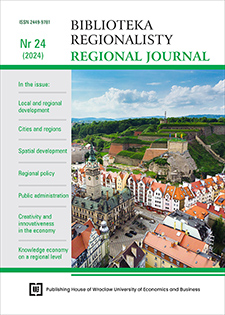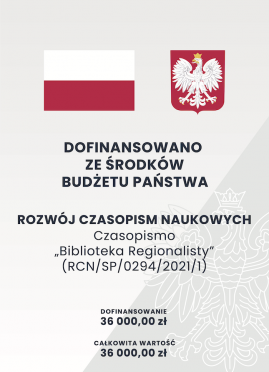New York City’s response to COVID-19 in the context of the smart city concept
DOI:
https://doi.org/10.15611/br.2024.1.06Keywords:
COVID-19, the pandemic, smart city, New York, resilienceAbstract
Aim: This study aims to critically assess how New York City’s response to the COVID-19 pandemic aligns with the principles of the smart city concept. Expanding upon an earlier study focused on the initial, ad hoc urban responses, this research examines the entire duration of the pandemic, highlighting strategic shifts and long-term adaptations in crisis management and urban resilience.
Methodology: The study employs a case study approach, analysing policy documents, statistical data, and secondary sources to assess New York City’s transition from immediate crisis response to structured recovery efforts. A qualitative assessment of governance strategies, social equity measures, and sustainability policies forms the basis of the evaluation.
Results: The study reveals that while New York City made strides in job recovery and economic revitalization, its response to the COVID-19 pandemic exposed persistent disparities in digital access, environmental justice, and social equity. The city implemented smart city-aligned initiatives, such as digital transformation efforts and sustainability programs, but challenges in governance, public trust, and equitable resource distribution hindered comprehensive resilience. The uneven recovery process highlighted gaps in long-term crisis management, emphasizing the need for a more inclusive and adaptive approach to urban resilience.
Implications and recommendations: The study underscores the necessity for a more integrated and inclusive approach to urban crisis management. It highlights the importance of addressing systemic inequalities and ensuring equitable access to technology and resources to fully realize the smart city vision.
Originality/value: This research contributes to the discourse on smart city resilience by offering a longitudinal perspective on New York City’s pandemic response. It provides valuable insights into the complexities of urban governance in times of crisis and the role of smart city strategies in fostering sustainable recovery.
Downloads
References
2ThinkNow. (n.d.). Innovation Cities™ Index 2022-2023: Global 500 world’s most innovative cities. https://innovationcities.com/worlds-most-innovative-cities-2022-2023-city-rankings/26453/
A Division of the New York Department of State. (2023). Adopting local laws in New York State. James A. Coon Local Government Technical Series. https://dos.ny.gov/system/files/documents/2023/01/adopting-local-laws-in-nys_1.pdf (Original work published 1998).
Buildinnyc. (n.d.). Top tech companies in NYC, NY. https://www.builtinnyc.com/companies
Cheshire, L., & da Silva, J. (2024, March 26). The 100 most popular art museums in the world-blockbusters, Bots and bouncebacks. The Art Newspaper, https://www.theartnewspaper.com/2024/03/26/the-100-most-popular-art-museums-inthe-world-2023
Coalition for the Homeless. (2024a). Facts about homelessness. https://www.coalitionforthehomeless.org/facts-abouthomelessness
Coalition for the Homeless. (2024b). New York City homelessness. The basic facts. https://www.coalitionforthehomeless.org/wpcontent/uploads/2024/01/NYC-Homelessness-Fact-Sheet-11-2023_citations.pdf
Dupas, P., Fafchamps, M., & Lestant, E. (2023). Panel data evidence on the effects of the COVID-19 pandemic on livelihoods in urban Côte d’Ivoire. PLOS ONE, 18(2), e0277559. https://doi.org/10.1371/journal.pone.0277559
IESE Business School. (2020). IESE Cities in Motion Index. https://www.iese.edu/media/research/pdfs/ST-0542-E.pdf
IESE Business School. (2022). IESE Cities in Motion Index. https://www.iese.edu/media/research/pdfs/ST-0633-E.pdf
IESE Business School. (2024). IESE Cities in Motion Index. https://www.iese.edu/media/research/pdfs/ST-0649-E
IMD. (2020). Smart City Index 2020. https://imd.cld.bz/Smart-City-Index-2020
IMD. (2023). Smart City Index Report 2023. https://imd.cld.bz/IMD-Smart-City-Index-Report-20231
Kozak, A. (2022). The role of smart cities during the COVID-19 pandemic – the example of New York City. Biblioteka Regionalisty. Regional Journal, 22, 23-33. https://doi.org/10.15611/br.2022.1.03
Li, Y., Chai, Y., Chen, Z., & Li, C. (2023). From lockdown to precise prevention: Adjusting epidemic-related spatial regulations from the perspectives of the 15-minute city and spatiotemporal planning. Sustainable Cities and Society, 92, Article 104490. https://doi.org/10.1016/j.scs.2023.104490
Mayor’s Office of Management and Budget. (2024). Labor statistics for the New York City region. https://dol.ny.gov/laborstatistics-new-york-city-region
Mehranbod, C., Bushover, B., Gobaud, A., Eschliman, E., Fish, C., Zadey, S., & Gao, X. (2024). New York City sees uptick in transit assaults since pandemic start. https://www.publichealth.columbia.edu/news/uptick-nyc-transit-assault-rateduring-covid-pandemic-has-not-returned-pre-pandemic-levels-despite-subway-safetyplan?utm_source=miragenews&utm_medium=miragenews&utm_campaign=news Moreno, K. (2021). Definition of the 15-minute city: What is the 15-minute city? https://www.researchgate.net/publication/362839186_Definition_of_the_15-minute_city_WHAT_IS_THE_15-MINUTE_CITY
Moreno, C., Allam, Z., Chabaud, D., Gall, C., & Pratlong, F. (2021). Introducing the ‘15-minute city’: Sustainability, resilience and place identity in future post-pandemic cities. Smart Cities, 4(1), 93–111. https://doi.org/10.3390/smartcities4010006
New York Building Congress. (2023). The next 100 years: A strategic blueprint. https://buildingcongress.com/wpcontent/uploads/2024/04/2023_Strategic_Blueprint_FINAL.pdf
New York City Council. (2021). Access to Internet in NYC. https://council.nyc.gov/data/internet-access
New York City Council. (2024). Emergency food in NYC. https://council.nyc.gov/data/emergency-food-in-nyc
New York City Economic Development Corporation. (2022a). Hunts Point forward. A vision for the future. https://edc.nyc/sites/default/files/2023-09/Hunts-Point-Forward-Vision-Plan-Web-English.pdf
New York City Economic Development Corporation. (2022b). Making New York work for everyone. https://edc.nyc/sites/default/files/2023-02/New-NY-Action-Plan_Making_New_York_Work_for_Everyone.pdf
New York City Police Department. (2024). Seven major felony offenses. https://www.nyc.gov/assets/nypd/downloads/pdf/analysis_and_planning/historical-crime-data/seven-major-felonyoffenses-2000-2023.pdf
New York City. (2023). NYC travel & tourism outlook. https://assets.ctfassets.net/1aemqu6a6t65/2Y8QEeyL0WPqNNSp2PF4tb/101bf1f52b3a6a530beca022c73526c5/2023_ New York State. (2024). Labour statistics for the New York City region. https://dol.ny.gov/labor-statistics-new-york-city-region Travel__Tourism_Outlook_July_Update.pdf
New York State, Department of Labor. (2024). NYS private sector employment up 3,200 jobs in February 2024. https://dol.ny.gov/system/files/documents/2024/03/nys-private-sector-employment-up-3200-jobs-in-february-2024.pdf
Noszczyk, T., Gorzelany, J., Kukulska-Kozieł, A., & Hernik, J. (2022). The impact of the COVID-19 pandemic on the importance of urban green spaces to the public. Land Use Policy, 113, Article 105925. https://doi.org/10.1016/j.landusepol.2021.105925
NYC. (2023). Lower Manhattan coastal resiliency. February 22nd, 2023 Community Board 1 update. https://www.nyc.gov/assets/lmcr/downloads/pdf/LMCR_CB1_February_2023FNL.pdf
NYC. (2024). Rebuild, renew, reinvent. New York City’s economic recovery. https://www.nyc.gov/assets/operations/downloads/pdf/mmr2023/economic_recovery.pdf NYC Office of Technology & Innovation. (2022). Strategic plan. https://www.nyc.gov/assets/oti/downloads/pdf/about/strategicplan-2022.pdf#page=10
NYU Langone. (2023). COVID-19 contact tracing program in NYC scaled up quickly: Improvements needed for next pandemic. https://nyulangone.org/news/covid-19-contact-tracing-program-nyc-scaled-quickly-improvements-needed-nextpandemic
Office of the New York. (n.d.). New York City industry sector dashboards. https://www.osc.ny.gov/osdc/reports/nycsectors/construction?__cf_chl_tk=o2R10MLgupQM7pXKJZilQJK4odxHEIrmGZbY9Zbw8c0-1724315677-0.0.1.1-8830
Office of the State Deputy Comptroller for the City of New York. (2023a). NYC’s shifting population: The latest statistics (Report 15-2024). Office of the New York State Comptroller. https://www.osc.ny.gov/files/reports/osdc/pdf/report-15-2024.pdf
Office of the State Deputy Comptroller for the City of New York. (2023b). Residential real estate in NYC: Rising tax bills during COVID fuel disparities (Report 7-2024). Office of the New York State Comptroller. https://www.osc.ny.gov/files/reports/osdc/pdf/residential-real-estate-in-nyc.pdf
Office of the State Deputy Comptroller for the City of New York. (2024). Tracking the return: The tourism industry in New York City (Report 04-2025). Office of the New York State Comptroller. https://www.osc.ny.gov/files/reports/pdf/report-042025.pdf
Office State of New York. (2024). Food insecurity persists post-pandemic. https://www.osc.ny.gov/reports/food-insecuritypersists-post-pandemic
Partnership for New York City. (2024). Return to office survey results. https://pfnyc.org/research/return-to-office-surveyresults-may-2024
Phenix, K. (2024). Tackling food insecurity on the rise in New York. https://www.nynmedia.com/news/2024/01/tackling-foodinsecurity-rise-new-york/393129
The City of New York. (2023). Mayor Adams announces NYC hits all-time high in total jobs, recovery of nearly 1 million jobs lost during pandemic. https://www.nyc.gov/office-of-the-mayor/news/796-23/mayor-adams-nyc-hits-all-time-hightotal-jobs-recovery-nearly-1-million-jobs-lost
The City of New York. (2024). Transcript: Mayor Adams appears on ABC’s “Up Close With Bill Ritter”. https://www.nyc.gov/office-of-the-mayor/news/644-24/transcript-mayor-adams-appears-abc-s-up-close-bill-ritterThe New York City. (2022). Rebuild, renew, reinvent: A blueprint for New York City’s economic recovery. https://www.nyc.gov/assets/home/downloads/pdf/office-of-the-mayor/2022/Mayor-Adams-Economic-RecoveryBlueprint.pdf
UN-Habitat. (2018). CityRAP Tool. City resilience, action planning tool. https://unhabitat.org/sites/default/files/documents/2019-05/cityrap-tool_booklet_05032019-compressed.pdf
Wang, S., & Laefer, D. F. (2024). Modeling food-related business closure in select New York City communities using multiscale and spatial features. Environment and Planning B: Urban Analytics and City Science, 52(1), 247-264. https://doi.org/10.1177/23998083241254573
Whitaker, S. D. (2023). Urban and regional migration estimates, second quarter 2023 update. Federal Reserve Bank of Cleveland. https://doi.org/10.26509/frbc-ddb-20231114
World Health Organization. (2021). Weekly operational update on COVID-19. https://www.who.int/docs/defaultsource/coronaviruse/wou-2021-8march-project.pdf
World Health Organization. (2024). WHO COVID-19 dashboard. https://data.who.int/dashboards/covid19/deaths
Zhu, X., & Xu, J. (2023). After the pandemic is before the pandemic: Rethinking urban priorities, assumptions and planning approaches. Heliyon, 9(10), e20763. https://doi.org/10.1016/j.heliyon.2023.e20763
Downloads
Published
Issue
Section
License
Copyright (c) 2025 Alicja Kozak

This work is licensed under a Creative Commons Attribution-ShareAlike 4.0 International License.
Accepted 2024-10-24
Published 2025-01-31







